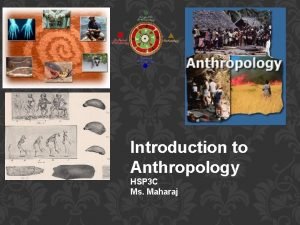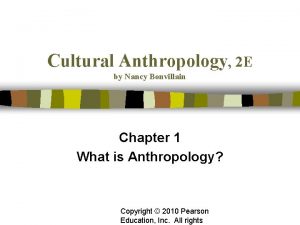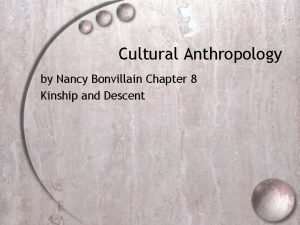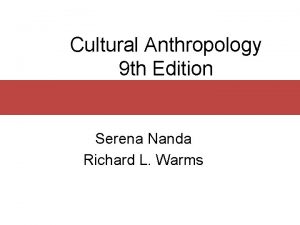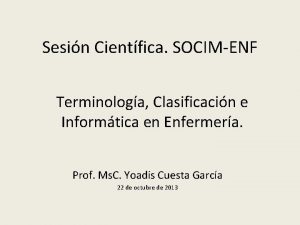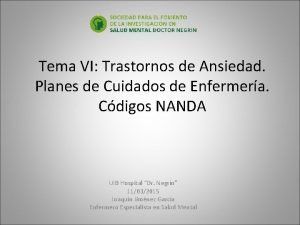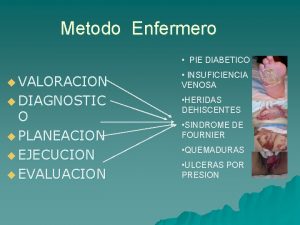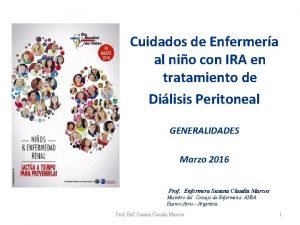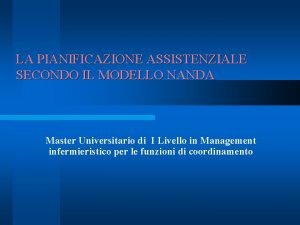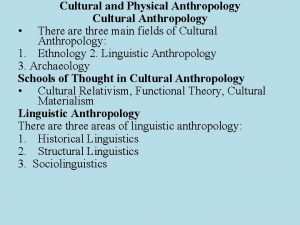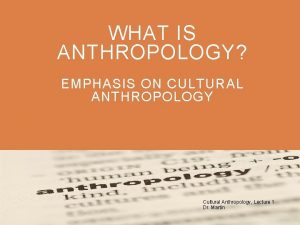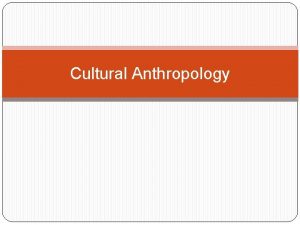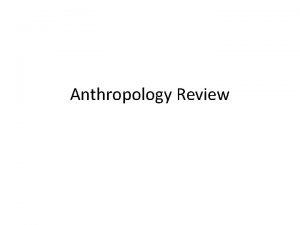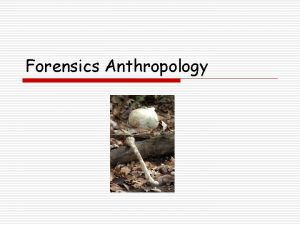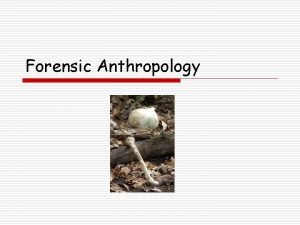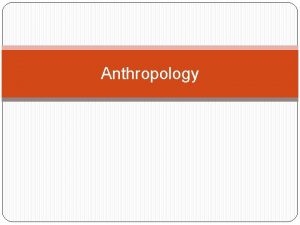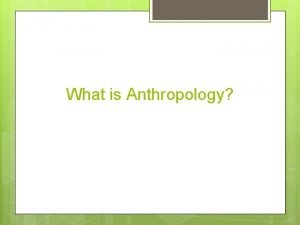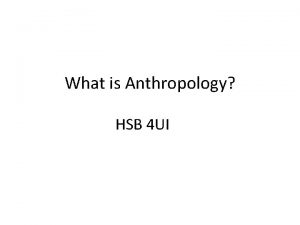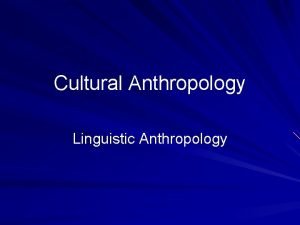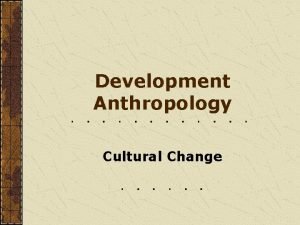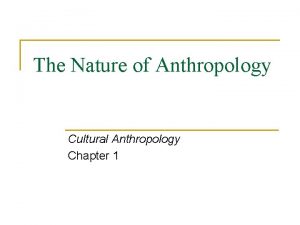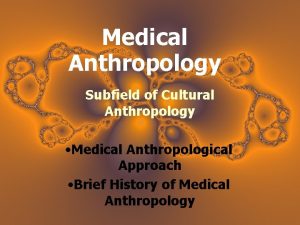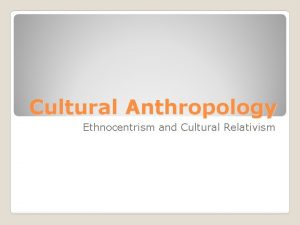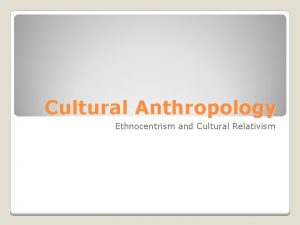Cultural Anthropology 9 th Edition Serena Nanda Richard





































- Slides: 37

Cultural Anthropology 9 th Edition Serena Nanda Richard L. Warms

Chapter 1 Anthropology and Human Diversity

Chapter Outline Specialization on Anthropology § What We Learn from Anthropology: Understanding Human Differences § Anthropological Approaches to Culture §

Goals of Anthropology Describe, analyze and explain different cultures. § Show groups adapted to their environments and gave meaning to their lives. § Comprehend the entire human experience. §

Holistic Approach Considers cultures, history, language and biology essential to a complete understanding of society. § Separates anthropology from other disciplines, which focus on one factor, biology, psychology, physiology, or society, to explain human behavior. § Anthropology seeks to understand human beings as whole organisms who adapt to their environments through a complex interaction of biology and culture. §

Areas of Specialization § § § Cultural Anthropology Linguistic Anthropology Archaeology Physical Anthropology Applied Anthropology

Cultural Anthropology The study of human behavior that is learned rather than genetically transmitted, and that is typical of groups of people. § Society is the set of social relationships among people within a given geographical area. § Culture is the learned behaviors and symbols that allow people to live in groups. §

Examples of Cultural Anthropology Political and legal anthropology - concerned with issues of nationalism, citizenship, the state, colonialism, and globalism. § Humanistic anthropology - focused on the personal, ethical, and political choices facing humans. § Visual anthropology - the study of visual representation and the media. §

Linguistic Anthropology Focus on understanding language and it’s relation to culture. – Development of language – Variation of languages. – Relationship of language to culture. – How languages are learned. § Historical linguists study how languages are related to each other. §

Archaeology Study of past cultures through their material remains. § Prehistoric societies are those with no usable written records. – Artifact - A material remain of a past culture. • Archaeologists interpret artifact’s function by precise position in which it was found. – Features are artifacts that cannot easily be moved, such as ruins of buildings, burials, and fire pits. §

Question § Examples of artifacts include all except which one of the following? a) holiday wreath b) stone axe c) rock painting d) wild raspberries e) tortilla

Answer: d § Examples of artifacts include holiday wreath, stone axe, rock painting and tortilla. Wild raspberries are not artifacts.

Archaeology: Specialties Urban archaeology Archaeological investigation of current-day cities. § Cultural resource management Protection and management of archeological, archival, and architectural resources. §

Physical Anthropology Study humans from a biological perspective. § Paleoanthropology: Biological processes of human adaptation. § Human variation: Physiological differences among modern humans. § Primatology: Study of apes for clues about the human species.

Applied Anthropology Analyze social, political and economic problems and develop solutions. § Example: Cultural anthropologists have been instrumental in promoting the welfare of tribal and indigenous peoples. §

Indigenous People § Groups of people who have occupied a region for a long time and are recognized by other groups as original (or very ancient) inhabitants. – They are often minorities with little influence in the government of the nationstate that controls their land.

Medical Anthropology Draws upon social, cultural, biological, and linguistic anthropology to better understand those factors that influence health and wellbeing. § It is concerned with the experience of disease as well as its distribution, prevention, and treatment. §

Forensic Anthropology § Study and identification of skeletized or badly decomposed human remains.

Question § A museum exhibit of an early one-room school in the Midwestern U. S. is being planned. Which subfield(s) of anthropology would be likely to carry out the research and interpretation of surveyor's maps, diaries, textbooks, journals, and other historic artifacts, as well as excavation of the original site? a) paleontologist and archaeologist b) archaeologist c) cultural anthropologist and archaeologist d) forensic anthropologist and cultural anthropologist e) biological anthropologist

Answer: b § A museum exhibit of an early one-room school in the Midwestern U. S. is being planned. An archaeologist would be likely to carry out the research and interpretation of surveyor's maps, diaries, textbooks, journals, and other historic artifacts, as well as excavation of the original site?

Ethnocentrism Belief that one’s culture is better than all other cultures. § Measures other cultures by the degree to which they live up to one’s own cultural standards. §

Ethnocentrism When a culture loses value for its people, they may experience anomie, a condition where social and moral norms are absent or confused. § Racism is the belief that some human populations are superior to others because of inherited, genetically transmitted characteristics. §

Question § Some positive aspects of the tendency for members of societies to be ethnocentric would include which one of the following? a) Ethnocentrism often supports existing social inequality, especially in multicultural societies. b) Ethnocentrism may reinforce group solidarity and helps perpetuate cultural values. c) Ethnocentrism is often associated with racism. d) Ethnocentrism in technologically advanced societies reinforces people's ideas about their own superiority and often, military strength.

Answer: b § Some positive aspects of the tendency for members of societies to be ethnocentric would include: Ethnocentrism may reinforce group solidarity and helps perpetuate cultural values.

Biological Diversity Wide diversity in human shapes and colors, low levels of skeletal and blood type diversity. § People from the same region tend to share more traits than they do with people from distant lands. § Biopsychological Equality - The fact that all human groups have the same biological and mental capabilities. §

Racial Classification Race is socially constructed. § No group of humans is biologically different from another. § Humans have an equal capacity for culture. §

Racism The idea that characteristics are caused by racial inheritance. § Differences among human groups are the result of culture. § Humans belong to the same species with the same features essential to life. §

Racialism § Ideology that claims there are biologically fixed races with different moral, intellectual, and physical characteristics that determine individual aptitudes and that such races can be ranked on a single hierarchy.

Cultural Relativism § Understanding values and customs in terms of the culture of which they are a part.

Emic and Etic Views of Culture Emic: Describes the organization and meaning a culture’s practices have for its members. § Etic: Tries to determine the causes of particular cultural patterns that may be beyond the awareness of the culture being studied. §

Quick Quiz

1. Which of the following does not characterize the anthropological approach to the study of human societies and their cultural traditions? a) culturally relativistic b) Holistic c) Ethnocentric d) Comparative e) consideration of evolutionary and historical context

Answer: c • The ethnocentric approach does not characterize the anthropological approach to the study of human societies and their cultural traditions.

2. Which of the following is not a topic with which present-day biological (physical) anthropologists are engaged? a) primate physiology, morphology, and behavior b) human variation c) interaction between biological and cultural factors in evolution d) establishing fixed categories of "race" e) human origins

Answer: d • Establishing fixed categories of "race” is not a topic with which present-day biological (physical) anthropologists are engaged.

3. The study of how people explain the causes of ill health, along with the meanings they attach to it, is an important part of the subspecialty known as a) biological anthropology. b) medical anthropology. c) paleoanthropology. d) forensic anthropology. e) Cultural Resource Management (CRM).

Answer: b § The study of how people explain the causes of ill health, along with the meanings they attach to it, is an important part of the subspecialty known as medical anthropology.
 Physical and cultural anthropology
Physical and cultural anthropology Sociocultural system
Sociocultural system Cultural anthropology nancy bonvillain
Cultural anthropology nancy bonvillain Cultural anthropology nancy bonvillain
Cultural anthropology nancy bonvillain Cultural anthropology examples
Cultural anthropology examples What is anthropology
What is anthropology King richard iii and looking for richard
King richard iii and looking for richard Using mis 10th edition
Using mis 10th edition Mis chapter 6
Mis chapter 6 Nanda nsg lmplemntation of appndectomy
Nanda nsg lmplemntation of appndectomy Risicodiagnose
Risicodiagnose Short term goal ncp
Short term goal ncp Askep preeklamsia nic noc
Askep preeklamsia nic noc Arup nanda exadata
Arup nanda exadata Nanda nic noc voorbeeld
Nanda nic noc voorbeeld Sepsis neonatal temprana y tardía
Sepsis neonatal temprana y tardía Hypoglycemia symptoms
Hypoglycemia symptoms Diagnostico potencial
Diagnostico potencial Ansiedad plan de cuidados
Ansiedad plan de cuidados Nanda klassifikation
Nanda klassifikation Exemplo de diagnóstico de enfermagem nanda
Exemplo de diagnóstico de enfermagem nanda Nic in nursing
Nic in nursing Risk diagnosis example
Risk diagnosis example Insuficiencia venosa nanda
Insuficiencia venosa nanda Nanda chart
Nanda chart Características do choque hipovolêmico de classe iii
Características do choque hipovolêmico de classe iii Jufdanielle bloedgroep
Jufdanielle bloedgroep Risicodiagnose
Risicodiagnose Askep nyeri akut
Askep nyeri akut Nanda 2020-2022
Nanda 2020-2022 Pae sepsis neonatal
Pae sepsis neonatal Nursing diagnosis for poor appetite
Nursing diagnosis for poor appetite Nursing diagnosis for vision impairment
Nursing diagnosis for vision impairment Nanda
Nanda Diagnostico de nanda
Diagnostico de nanda Alcalosis metabolica valores
Alcalosis metabolica valores Perdida de calor recien nacido
Perdida de calor recien nacido Problemi collaborativi nanda
Problemi collaborativi nanda
